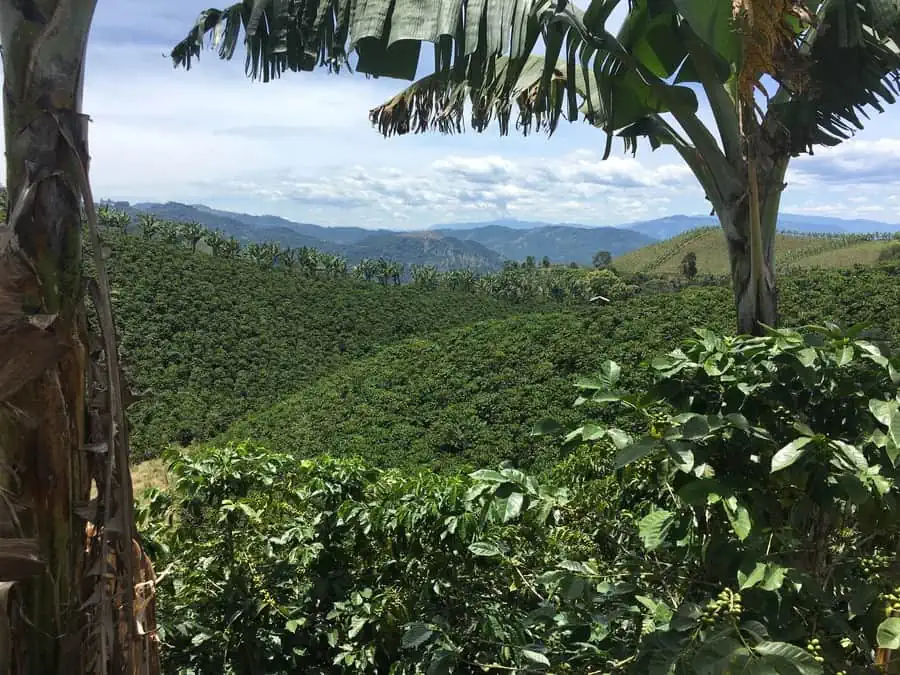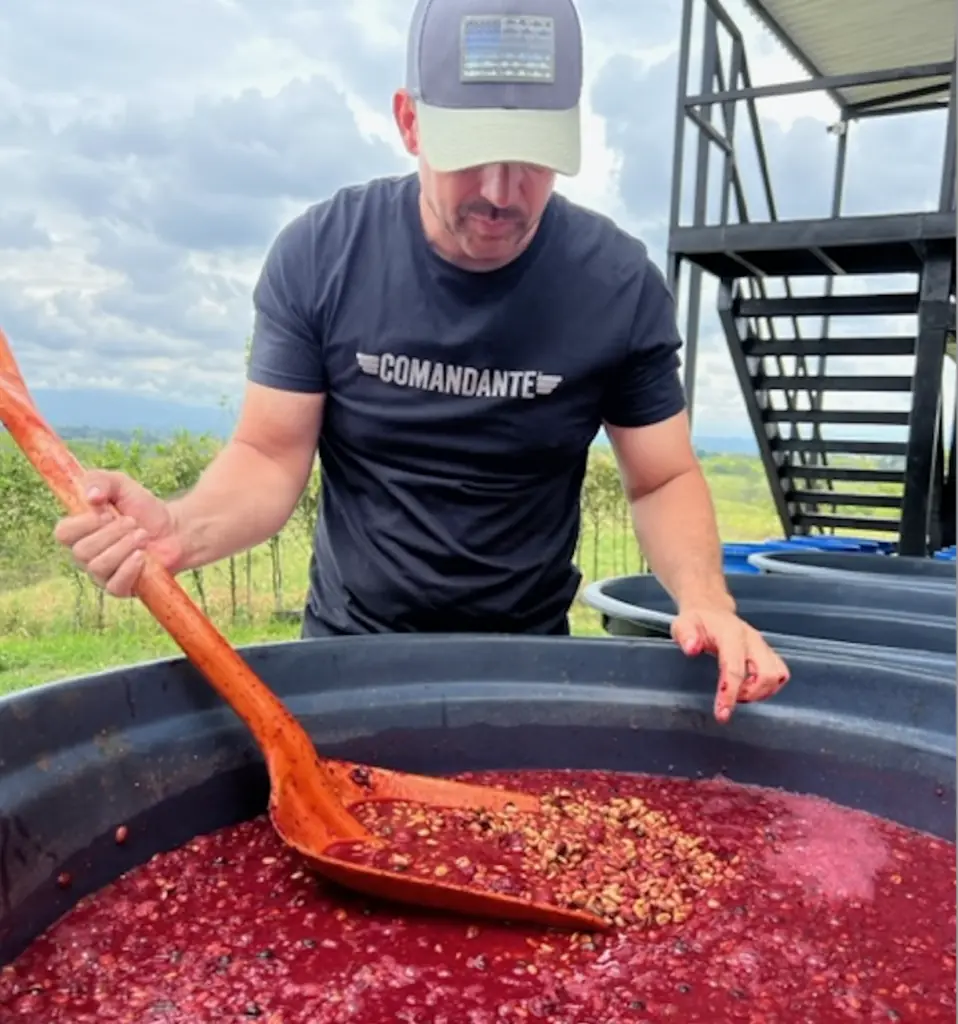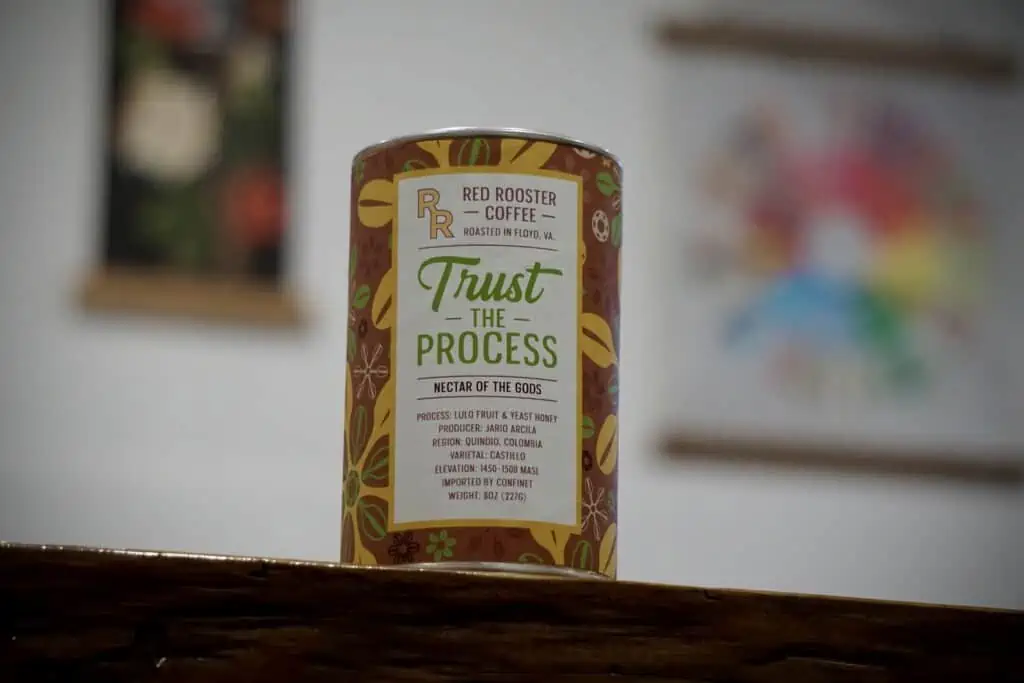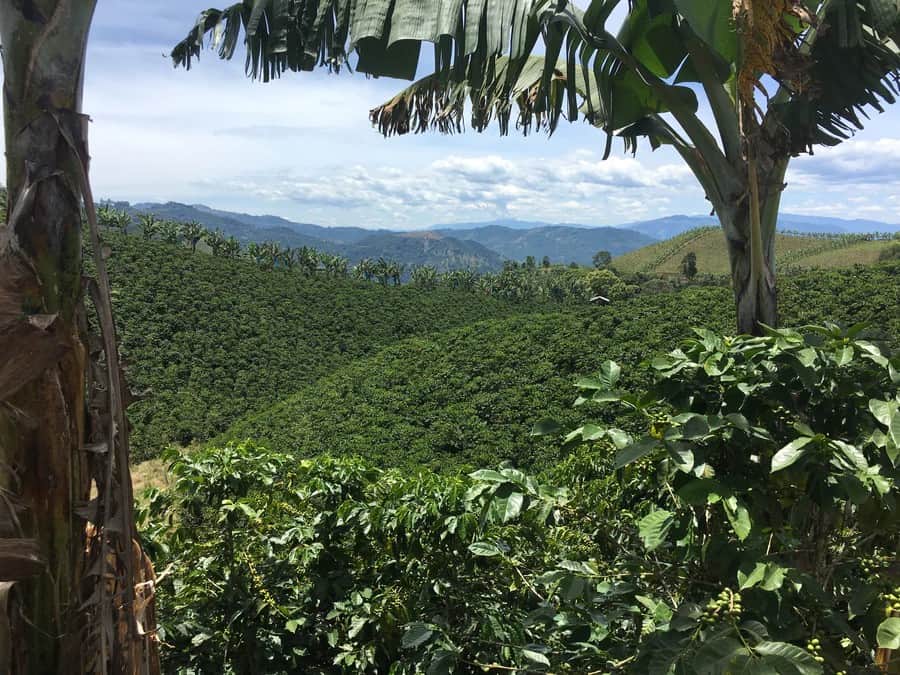
Finca La Loma in Costa Rica’s Tarrazu rising area. Courtesy of David’s Nostril.
On the experimental tip of the specialty espresso world, the joy by no means stops. The most recent processing twist from Colombian and Central American espresso growers entails placing pure fruit, herbs or spices into the fermentation tank with the espresso throughout processing. The fermentation tanks are normally sealed, making this fermentation anaerobic as nicely. Readers of our March 2023 report know that anaerobic fermentation tends to create tangy candy (typically very tangy candy) profiles with shocking taste notes. Essentially the most excessive anaerobics will be excessively candy with artificial-tasting, cologne-like flower and candyish notes. However we additionally discovered with that March report that not all coffees processed this fashion go over the sting into cologne/sweet territory. Many are extraordinary profiles which will offend purists, however are balanced and full, profiles that learn as espresso, but distinctive and unique espresso.
On this newest report, we tiptoe on into the following, extra controversial processing frontier: anaerobic-fermented espresso that additionally has had fruit or spice added to the sealed tanks throughout fermentation. In some circumstances, the fruit could also be acquainted to North People. Varied pink fruits, together with strawberries, have been deployed in Korean roaster Prism Espresso Works’ El Vergel Rojo Fruit Infused, reviewed right here at 93. With different samples, the fruit was much less acquainted, as with the 94-rated Colombia Santa Monica Castillo Honey Lulo from Virginia-based roaster Purple Rooster, during which tart little fruits Colombians name lulo have been added to the tank.
Names assigned to fruit-added processing strategies range — fruit infused, co-fermented, fruit macerated, additive fermented — presumably a symptom of the controversy that has developed across the observe within the specialty espresso world. That controversy additionally might have contributed to the comparatively few samples we obtained for this report: 26 samples from 15 roasters (six U.S.), versus the 90 samples from 90 roasters that crammed our lab once we despatched out a name for the easy anaerobic coffees (no components) for our March 2023 report.
Nothing Just like the Outdated Flavored Coffees
Earlier than moving into the controversy a part of the story, nevertheless, one essential level must be made: These coffees don’t resemble the outdated, once-popular artificially flavored coffees. Right here, nothing intrudes on the character of the espresso as explicitly as did these synthetic flavors with their cloying pop-culture nature and metallic end. In actual fact, I discovered it tough to establish the precise fruit added to the tank, even when I knew the title and was usually accustomed to the style of the fruit. I’d get fruit, sure, however nail the precise id of that fruit? Near unattainable.

Co-fermenting espresso cherries with raspberries at Finca Campo Hermoso in Colombia. Courtesy of Jared Hales, Hacea Espresso Supply.
Recall that the fruit is added as an integral a part of fermentation, a fancy chemical course of the main points of which stay comparatively unstudied. In different phrases, these coffees should not the results of a easy additive course of. They don’t take already processed espresso and add already processed fruit to it. The contemporary fruit and contemporary espresso react collectively to create a singular chemical occasion. Definitely, this explains the complexity of the fruit sensations that emerged in shocking and unpredictable methods in these coffees.
And the Controversy …
However, producers who add fruit to the tank are being accused of dishonest on the implicit guidelines of high quality espresso. The Cup of Excellence (COE), for instance, which manages a collection of extremely revered juried inexperienced espresso competitions, prohibits addition of fruits, spices or different nontraditional components to coffees entered of their competitions. The World Barista Championships embody a regulation with an analogous broad intent.
What number of roasters share this place? It’s exhausting to say, however the comparatively lukewarm response to this report might counsel that many roasters should not but all in with this newest processing innovation. However, they could merely be approaching it with warning and deliberation.
Enthusiasm and Reservations
True, some roasters appear bought. Caleb Walker of Montana’s RamsHead Espresso Roasters, whose Colombia Campo Hermosa Co-Fermented Honey (93) confirmed a very intense, juicy brightness, stories, “Personally, I’m actually having fun with fruit-infused coffees. The distinctive means of fruit infusion brings out a brightness that’s tough to search out in a standalone pure. The fruit infusions appear so as to add one other dimensional layer of taste to the cup profile.”

Virginia’s Purple Rooster Espresso Roaster submitted Colombia Santa Monica Castillo Honey Lulo, a espresso co-fermented with lulu fruit. Courtesy of Tony Greatorex.
Extra typical, nevertheless, was ambivalence. “As a rule, I’m not a fan of those coffees — I discover them to style and scent synthetic … and typically they’re simply downright unhealthy. Distinctive, positive, but in addition disagreeable,” writes Haden Polseno-Hensley, co-owner and co-founder of Purple Rooster Espresso. However Purple Rooster undoubtedly makes exceptions for the most effective of those coffees, together with this month’s Colombia Santa Monica Castillo Honey Lulo, a strikingly unique espresso comprehensively summed up by co-cupper Kim Westerman as delicately fruity, tartly floral, richly musky and enigmatically savory.
And though Youngjun Cho of Korea’s Prism Espresso Works complains that “many [fruit fermentations] have a powerful synthetic taste and don’t style like espresso,” he discovered a persuasive exception in his 93-rated El Vergel Rojo Fruit Infused, which confirmed a putting juxtaposition of sweetness and umami within the construction, supporting flowers and berry on the candy aspect and salted caramel on the umami. “These are nice ‘enjoyable’ coffees for novices,” he concludes.
Starter Coffees?
The attraction of those coffees for espresso novices and jaded regulars was a standard theme operating via roaster feedback. Ted Stachura of California-based Equator Espresso, whose Colombia Las Flores Mint Macerated (93) was considered one of my private favorites, with its herbs, flowers and deep however tactful sweetness, writes, “I see these co-fermented coffees as an avenue to excite the palates of even essentially the most informal espresso drinkers. Whereas it might be tough for the common espresso shopper to detect delicate taste nuances in historically processed coffees, there is no such thing as a mistaking the flavors within the fruit-/spice-infused coffees we’ve just lately been launched to. My hope is that these creatively fermented coffees is usually a gateway for weary espresso drinkers to start out fascinated with our favourite beverage in new methods.”
The Anaerobic Impression
What struck me most concerning the sensory character of those infused coffees, nevertheless, was how essential the influence of anaerobic processing was to their originality, extra essential maybe than the added fruit or spice. With the most effective of those coffees, the fruit infusion inspired engaging and intriguing aroma/taste issues, definitely, however the underlying structural originality of most of those profiles appeared in the end pushed by their tangy lactic-acid construction, the results of anaerobic fermentation. The fruit primarily contributed extra fragrant complication and originality.
For instance, Gary Liao of Taiwan’s GK Espresso submitted a espresso that was co-fermented with fruit however not anaerobically fermented. Passionfruit was merely mixed with the freshly pulped espresso in a standard open-top fermentation tank throughout conventional moist processing of the Colombia Finca Monteblanco Purple Caturra Passionfruit Washed (92). The result’s a easy, intriguing espresso, however not as unique or putting as a lot of the different co-fermented coffees. It impresses with a fairly satisfying however moderately basic profile pushed by tart fruit and almond notes.
The Newest Producer-Pushed Innovation
This observe of including contemporary fruit or herbs to the fermentation tank is, after all, simply the newest in a string of product improvements pioneered on the farming finish of the espresso provide chain, moderately than on the consuming finish. Till round 2004, the improvements in espresso that bought shoppers concerned and excited all originated within the consuming context: promoting complete bean espresso out of bins, for instance; roasting all coffees darkish; the advanced improvements of espresso delicacies; and the notorious artificially flavored coffees talked about earlier. In all of those circumstances, good, consistent-quality espresso was merely the uncooked materials for adjustments wrought by city-centered roasters and cafes, most in North America and Europe.
Issues began altering round 2004, when producers started promoting high-quality pure, or dry-processed espresso moderately than the standard clear wet-processed varieties, kicking off a complete sequence of improvements in processing designed to excite shoppers and fulfill our obvious want for novelty: pure processing, honey processing, varied variations of anaerobic fermentation, and now fruit infusion. On the identical time improvements in selection, led by the revelation of Geisha/Gesha in 2004, equally shifted the locus of innovation from consuming to producing context.
A Plus for Producers?
The truth that this newest espresso fashion was pioneered by espresso farmers or producers has been taken as a continued indication of the brand new significance of producers and producing nations as facilities for change and innovation in espresso. That is true, and for these of us who, for varied causes, political and aesthetic, have a tendency to tug for producers and the International South, a cheerful growth. What could also be debatable is whether or not co-fermentation is, within the massive image, a optimistic growth for a variety of producers. It definitely highlights producers as artists and innovators and helps focus shoppers on their contributions and significance.
However, as multiple submitting roaster identified, what exalts the creativity of some well-positioned producers with good connections might not assist less-fortunate producers caught on the finish of a foul street. Attaining good outcomes with earlier improvements, like pure and honey processing, requires data and care from the farmer, however not fairly the meticulous management demanded by anaerobic processes.
Euphora Espresso’s Might Wang factors out: “Including fruit throughout espresso cherry fermentation can have an effect, nevertheless it requires intensive analysis and experiments to find out the way it impacts the flavour traits of espresso. The fruit fermentation technique necessitates cautious management of all controllable variables for producers, which can lead to elevated labor prices. On this planet of fermentation, microorganisms and sugar molecules should work together in a really particular technique to obtain a radical transformation of the content material. Failure to watch exterior variables comparable to temperature and oxygen ranges might result in the manufacturing of poor-tasting espresso beans.”
Polseno-Hensley of Purple Rooster provides: “I consider processes like [co-fermentation] are based mostly on producers feeling that they’re compelled to innovate, largely on account of the truth that rising unique and delicate high-elevation varietals is getting tougher due to local weather change. Small producers are turning to the thought of components in processing to boost the fruit and acidity of heartier disease-resistant varieties that wouldn’t usually fetch such excessive costs.”
Additionally, we in North America typically carry round a psychological image of “espresso producer” as a fellow in a white shirt and sombrero from Central or South America, whereas espresso producers vary from remoted villagers excessive within the mountains of Papua New Guinea to all-women co-ops in northern Sumatra to industrialized Brazilian farms. Whether or not the broader neighborhood of espresso producers steadily buys into these new prospects will decide their long-term influence on the espresso world.
A Final Notice
These outdoors the specialty espresso custom most likely don’t grasp how ambivalent many people really feel with respect to co-fermented coffees. We assist creativity and pleasure, however for many people, the notion of altering the essential style profile of espresso, typically moderately radically, by combining espresso with different non-coffee stuff is disturbing, even when achieved with the subtlety displayed by this month’s coffees. The stubbornness with which the foundations committees of the 2 main espresso competitions (COE and WBC) resist permitting co-fermented coffees to compete of their occasions suggests, I believe, the persistence of this basic unease. Are we contemplating the excellence of espresso manufacturing from tree to bean as a coherent act of custom and fervour, or are we’re we merely celebrating cute tips on the finish of that course of?
Troublesome to say, after all. In all probability finest to benefit from the wealthy vein of ambivalence operating via roaster feedback this month and, above all, expertise the solutions proposed by the 9 wonderful co-fermented coffees we evaluation right here.
Due to the roasters who significantly enriched this report by sharing their concepts and expertise concerning anaerobic coffees: Youngjun Cho, prism espresso works, Korea; David of David’s Nostril Espresso, Taiwan;Tony Greatorex, Purple Rooster Espresso, USA; Gary Liao, GK Espresso, Taiwan; Haden Polseno-Hensley, Purple Rooster Espresso, USA; Ted Stachura, Equator Espresso, USA; Caleb Walker, RamsHead Espresso, USA; Might Wang, Euphora Espresso, Taiwan; Van Wang, Riika Café, Taiwan.

